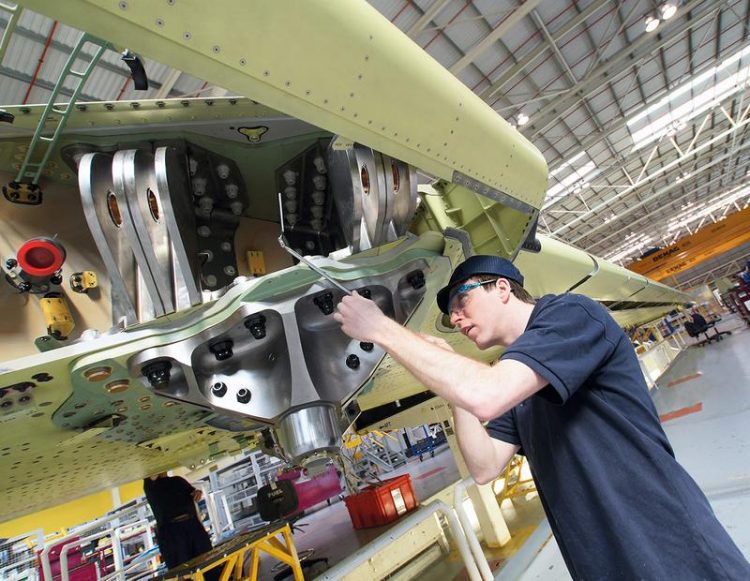Workplace ergonomics: Camera identifies unhealthy movements

In order that workers stay healthy as long as possible, ergonomic movements are of great importance. Researchers of Hannover are developing a system which identifies and corrects unhealthy postures. (Photo: Department for Business, Innovation and Skills / Creative Commons)
Back pain, knee problems, tenosynovitis: Wrong movements at work may cause permanent illness. To protect workers, researchers from Hannover are currently developing an ergonomics evaluation method: 3D cameras are to identify movement patterns and help correct unhealthy postures.
What is special about the new approach: The ergonomics evaluation is exclusively based on real-time camera data. Up to now, it is very complicated to analyse and assess movement patterns in the daily work routine of a factory.
The workers have to wear full length body suits with markers, so that the computer can recognize the position of hands, elbows and shoulders. This is inconvenient during work. In contrast, the new system is projected to go entirely without markers and sensors and just uses 3D cameras to identify body and hands.
In addition, the novel technology is able to analyse and evaluate movements immediately. State-of-the-art systems can just tape and process videos. Afterwards, an expert has to evaluate the video tape, in order to assess the ergonomics of the movements. This is expensive for the companies and unfavourable for the workers, since they have to wait for a feedback for days or even weeks. The new camera system is able to analyse movements automatically – in real time. It identifies unergonomic movements and also proposes alternatives. In this way, workers get direct feedback and can correct their unhealthy movements or postures immediately.
With the new system, companies are in the position to maintain the workforce of their staff permanently. Correct movements can be practised already during the initial job training and are checked consistently. In this way, assembly workers keep much longer fit, get less quickly tired and fall less frequently sick – an important factor for companies in times where responsibility for workers health may become expensive.
The new technology makes ergonomics evaluation also profitable for small and medium-sized companies. Since no full motion capturing body suit or inertia sensors or even an expert assessment are required, evaluation may well come at a lower price. Another advantage is that just one camera system is needed to evaluate all assembly workplaces. “We are developing a mobile system. As soon as a worker has adopted the correct movements, the cameras can be removed and installed at another assembly workplace”, says Sebastian Brede, project manager at the Institut für Integrierte Produktion Hannover gGmbH (IPH).
Within the scope of the research project “WorkCam – Real-time-capable camera-based ergonomics assessment and development of measures for the assembly process”, IPH is cooperating with the Institute of Production Systems and Logistics (IFA) of Leibniz Universität Hannover.
While researchers at IFA are concentrating on ergonomics assessment, IPH is responsible for the development of the camera system and the evaluation of 3D data. The project has started on 1 April 2017 and will continue until end of March 2019 – by then, the researchers want to develop a prototype of the camera system and get it tested with partner companies.
Companies interested in ergonomics evaluation, who want to test the system in the field, have still the opportunity to participate in the project. Please contact Sebastian Brede under (0511) 279 76-225 or send an email to brede@iph-hannover.de.
Media Contact
More Information:
http://www.iph-hannover.deAll latest news from the category: Information Technology
Here you can find a summary of innovations in the fields of information and data processing and up-to-date developments on IT equipment and hardware.
This area covers topics such as IT services, IT architectures, IT management and telecommunications.
Newest articles

Properties of new materials for microchips
… can now be measured well. Reseachers of Delft University of Technology demonstrated measuring performance properties of ultrathin silicon membranes. Making ever smaller and more powerful chips requires new ultrathin…

Floating solar’s potential
… to support sustainable development by addressing climate, water, and energy goals holistically. A new study published this week in Nature Energy raises the potential for floating solar photovoltaics (FPV)…

Skyrmions move at record speeds
… a step towards the computing of the future. An international research team led by scientists from the CNRS1 has discovered that the magnetic nanobubbles2 known as skyrmions can be…





















